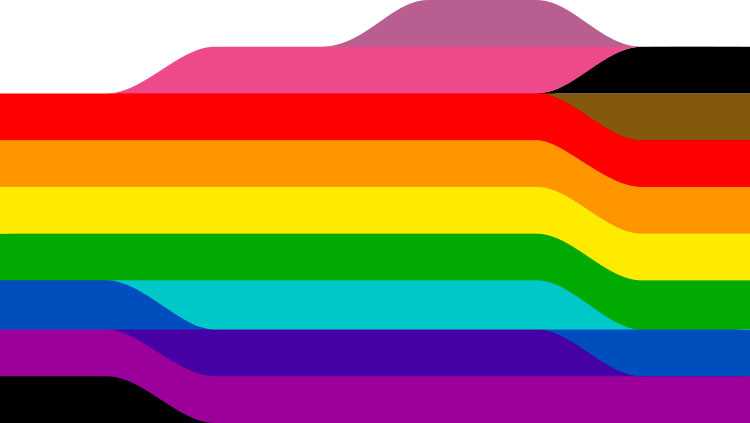Update: August 2020
As we planned how to mark Pride virtually in 2020 (see The Making of for more about our video), our LGBT+ network reflected on how we had incorporated the pride flag into our Auto Trader ‘Chevron' in 2019.
To this day, visibility remains such a paramount and organic part of our discussions. We're aware of the reach our social and professional platforms have. Our communities, colleagues, friends and families are at the absolute heart of our every intention. We strive to educate ourselves and others on matters that our network has committed to help change for the better.
This year, we made a unanimous decision to adopt Daniel Quasar's Progress Pride Flag design. This incorporates stripes to give visibility to trans and non-binary individuals (light blue, light pink, white), marginalized POC communities (brown, black), as well as those living with AIDS and the stigma and prejudice surrounding them, and those who have been lost to the disease (black).
Much has been written about the history of the pride flag, and there's no need to improve on those articles. It was created in 1978 by Gilbert Baker as an emblem of empowerment to represent a new movement. It replaced the Nazi's pink triangle that was still in use
Back in February 2019 Auto Trader changed its logo to recognise LGBT History Month, using the eight-colour version, first adopted by Philadelphia. We noticed some interesting reactions on social media. Some felt the gesture alienated other members of the LGBT+ community. Others were horrified that anyone had dared to change The Pride Flag.
The thing is, there is no The Pride Flag. As you can see from the graphic we've created, the colours have varied over the years. The original eight striped flag Gilbert Baker created in 1978 had a canton resembling the that of the flag of the United States. By the end of the year it was simply seven stripes. In 1979 was down to six stripes. In 2003 for its 25th anniversary Baker created a 1.25 mile eight colour version for Key West Pride.. In 2017 he created 39 hand-sewn nine colour rainbow flags to commemorate the 39th anniversary. Gilbert himself wrote of his gift to the world:
"This flag has no rules. It has no protocol that governs its display. It is the community's for the taking."- Gilbert Baker, 2007

The symbology used to represent LGBT+ communities over the years has changed an adapted. From Victorian green to Nazi pink and the purple 'sixties. Then the rainbow pride flag and—more recently—flags representing more distinct segments of the community.
So why is it important to represent our BAME community? What does it matter if there are six or eight stripes in the flag?
Section 28 arrived just months before I started primary school. In my first year of primary at the age of seven I saw one story book which had a picture of two men holding hands. That was the last positive reference to same sex relationships I saw in my education. And yet I felt supported and validated by arrival of television shows such as Queer as Folk and This Life. Each with its middle-class white male characters enjoying the freedom to be themselves and live their best life.
The reason I'm able to write this post from my privileged point of view (as a middle class cis-gendered white gay man), and the reason why I enjoy acceptance stems from decades of persecution, protest, legislation and education. It wasn't just people who looked like me who were fighting. The hugely significant Stonewall riots were started by two trans women, one black and one latina: Marsha P. Johnson and Sylvia Rivera.
I've had it easy and I know that's the product of a long fight, not just good luck. I believe that we need to continue to fight, to make things better for those with identities and orientations which don't have it as easy. The intersection of different identities can cause alienation and issues unique to those few.
Racism is experienced within the LGBT+ community by 79% and 80% of Asian and black gay men. - FS magazine's ‘Racism on the scene survey'
This is an issue of double discrimination. LGBT+ BAME people experience negative behaviour from more than one direction.
We recognised the Manchester Pride flag for what it was trying to achieve: highlighting the inequity faced by members of the BAME members of the LGBT+ community and uniting those in the LGBT+ community to support their kin. Rather than arguing about what the true pride flag is, let's remember what it represents: safety, the rich diversity of our community, and our united strength against oppression. Far from alienating anyone within the LGBT+ community, we want more of that community to feel safe.
This year Auto Trader employees, family & friends marching in Manchester Pride's parade will carry ten distinct flags. This is an effort to represent the range of identities and orientations that we try to cover with the term LGBT+: lesbian, gay, bi, transgender, transsexual, queer, questioning, intersex, ally, asexual, pansexual. With 820 we are statistically lucky enough that we should have people who identify with each of those terms, along with various other intersections. We are proud of each of them and grateful for how their diversity enriches us.
If you want to read more about Manchester Pride's decision, Mark Fletcher wrote in the MEN about how our city is flying the flag for equality and diversity. The Guardian has an article titled "No Asians, no black people. Why do gay people tolerate blatant racism?". Huffington Post has a good article about The History and Making of the Rainbow Pride Flag. And you can read excerpts from Gilbert Baker's memoir describing the origin story of the pride flag, or look at a gallery of pride flags over the years.
About the author
Mark Crossfield is a software developer at Auto Trader and co-leads our LGBT+ Network.

